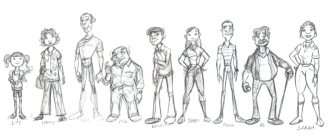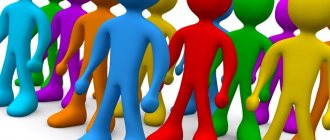Updated July 23, 2022 716 Author: Dmitry Petrov
Hello, dear readers of the KtoNaNovenkogo.ru blog. “This is character!” - we are talking about a person who is tough in his judgments, purposeful in life and unbending under the blows of fate.
As a rule, this remark is pronounced with a degree of envy and admiration. While “spineless” people do not evoke respect from others.
How does the first type of people differ from the second? And is it true that a person can lack character?
What is character
In fact, everyone has character. Translated from ancient Greek, this term literally means “sign”, “ feature ”, “ distinctive mark ”.
If we expand the definition, it turns out that character is a set of stable personality traits, properties of the psyche that determine a person’s behavior, reactions and other manifestations.
For example, in the same situation, people behave differently: a lonely, small kitten will evoke pity in someone and a desire to feed and warm it. Others will remain indifferent to the defenseless creature.
In the first case, a person is endowed with kindness, kindness, and the ability to sympathize with the misfortune of others - these are his distinctive features. In the second case they are absent.
Each person is endowed with his own unique set of characteristic features, so there are no two individuals who are absolutely identical in character. Even individuals who are very similar at first glance will still find differences among themselves.
Allport gradation
On the issue of classification of personality traits, the theory of the American psychologist Gordon Allport is quite well known. It is based on the fact that people’s characters differ in the set and level of development of their characteristics. He proposed to distinguish three types of dispositions:
Central character traits
Allport called central traits those that can be easily noticed in a person. Thus, these are the most striking characteristics. The average person may have between 5 and 10 central dispositions that accurately reflect the person's personality. Such traits may include responsibility, punctuality, friendliness and others.
Secondary Traits
Secondary dispositions are less noticeable, subject to constant change, and are often associated with taste preferences. For example, clothing style, hobbies, preferences in music, favorite dish or color.
Secondary dispositions, according to Allport, do not have a significant influence on a person’s behavior and actions, but are simply his additional characteristic features.
Cardinal features
Cardinal dispositions literally determine all the actions of an individual. They are also called dominant. Allport argued that few people have such traits. These are the most stable traits that predetermine the entire life of an individual. Cardinal dispositions include altruism, chauvinism, romanticism and others.
Human Character Traits
Character traits are a huge list of personal qualities, including kindness, cruelty, compliance, stubbornness, responsibility and irresponsibility, suspiciousness, courage and many others.
They can be either desirable or positive, or negative - which people often want to get rid of (become bolder, more confident).
The entire set of traits is usually divided into 4 large groups , each of which combines certain mental properties:
- Relationships with other people - openness or closedness, kindness or cruelty, arrogance or respect, and others.
- A person’s relationship with himself – self-criticism or arrogance, vanity or modesty, etc.).
- Attitude to work activity – neatness, carelessness, activity – laziness, responsibility – “careless” approach, etc.).
- The attitude towards material things is care or negligence.
All these traits are found in different proportions in different people, thus forming different types of character, which will be described below.
Mentalism
Human thoughts are not just some kind of immaterial substance, but real energy flows that can influence reality and even take on material form. And one confirmation of this is mental magic or, as it is increasingly called today, mentalism. But don’t let this introduction confuse you – there is nothing occult in this topic. Mental magicians, mediums and fortune tellers often use a set of techniques that have long been known and described in the literature. In the generally accepted understanding, mentalism is a special type of performing art that involves a person demonstrating various psychological experiments and experiments, as well as extrasensory abilities. We invite you to take a closer look at this phenomenon. Read more…
6
Character type
Scientists have not yet come to a consensus about what types of character there are. Various figures have developed their own classifications, the most popular of which are the following:
- E. Kretschmer connected the character and physique of a person . Thus, he got 3 types:
- asthenics or schizothymics are thin people with long arms and legs. Their main features are isolation, low adaptability and seriousness. There is a predisposition to schizophrenia;
- picnics or cyclothymics are short, prone to being overweight, with short limbs and a large head. Sociable and emotional people with developed sensitivity, easily adapt to circumstances. Prone to manic-depressive syndrome.
athletics or ixothimics - have tall stature, good body proportions and developed muscles. They are characterized by authority, desire for leadership, calmness and restraint. Negative character traits include the inability to adapt and show emotions. Prone to epilepsy;
- hyperthymic type – lively, energetic, sociable;
dysthymic - a slow, pessimistic person, withdrawn;
- extrovert - striving outward - sociable, energetic, lives in the world around him;
introvert - seeking inward - closed, lives in his inner world, the external world is not interesting to him.
- the oral type is characterized by dependence on other people’s opinions, immaturity, fear of rejection and the need for support from others;
masochistic – sensual, insightful, loves to suffer;
How physiognomy originated and developed
Physiognomy as a method of determining temperament by appearance arose. Britannica for a long time. For example, it was an integral part of ancient Greek practical psychology: Pythagoras could also The Attic Nights of Aulus Gellius. With An English Translation. John C. Rolfe. - Cambridge, London, 1927 refuse to take on a student who did not appear gifted.
Some researchers consider Physiognomy. Britannica Aristotle authored the first known treatise on physiognomy, but it was most likely Brennan, TC Review of [Aristoteles] Physiognomonica, edited by S. Vogt. Classical World is one of his followers. Six chapters of this work are devoted to The works of Aristotle. Clarendon Press. 1913 determination by external appearance of the preferred teaching method, character traits, strengths and weaknesses. The author compared Jenkinson J. Face facts: a history of physiognomy from ancient Mesopotamia to the end of the 19th century. The Journal of Biocommunication faces people with the faces of different animals and argued, for example, that a nose with a thick tip is a sign of insensitivity, sharp noses belong to hot-tempered people, and large and wide ones indicate a generous character.
Attention was also paid to the size of the head and the shape of the face in general. Thus, the author believed that people with large heads are prone to meanness; those with small faces are steadfast, those with broad faces are often stupid, and those with round faces are brave.
Physiognomy was used to make medical diagnoses and predict the future. It was also associated with Pythagoras' concept of four temperaments (sanguine, phlegmatic, choleric and melancholic), depending on the predominance of a certain fluid in the body - blood, phlegm, bile or black bile.
After the era of Antiquity, physiognomy again became Jenkinson J. Face facts: a history of physiognomy from ancient Mesopotamia to the end of the 19th century. The Journal of biocommunication became popular only in the 16th century. Doctors, philosophers and scientists of that time, like their predecessors, were looking for clues to human character. But if ancient physiognomy mainly described personality, then late medieval authors paid more attention to Jenkinson J. Face facts: a history of physiognomy from ancient Mesopotamia to the end of the 19th century. The Journal of biocommunication its astrological and predictive sides.
Even then there were critics of physiognomy. For example, Leonardo da Vinci wrote Leonardo (da Vinci), Chastel A. Leonardo on Art and the Artist. Courier Corporation. 2002 that physiognomy and palmistry have nothing to do with truth. This, however, did not stop him from asserting that hot-tempered people are characterized by wrinkles between their eyebrows.
One of the main physiognomists of that era was Jenkinson J. Face facts: a history of physiognomy from ancient Mesopotamia to the end of the 19th century. The Journal of biocommunication Italian scientist Giambattista della Porta. He is called the father of physiognomy, and Giambattista was inspired by the idea of determining personality traits by appearance through his studies in alchemy.
Illustration from Giambattista della Porta's book De Humana Physiognomonia. Image: Historical Anatomies on the Web
Illustration from Giambattista della Porta's book De Humana Physiognomonia. Image: Historical Anatomies on the Web
Illustration from Giambattista della Porta's book De Humana Physiognomonia. Image: Historical Anatomies on the Web
Illustration from Giambattista della Porta's book De Humana Physiognomonia. Image: Historical Anatomies on the Web
Illustration from Giambattista della Porta's book De Humana Physiognomonia. Image: Historical Anatomies on the Web
Illustration from Giambattista della Porta's book De Humana Physiognomonia. Image: Historical Anatomies on the Web
Illustration from Giambattista della Porta's book De Humana Physiognomonia. Image: Historical Anatomies on the Web
Illustration from Giambattista della Porta's book De Humana Physiognomonia. Image: Historical Anatomies on the Web
Physiognomy gained the greatest popularity Wiseman R., Highfield R., Jenkins R. How you looks betray your personality. NewScientist in the 18th–19th centuries. A special role in this was played by Jenkinson J. Face facts: a history of physiognomy from ancient Mesopotamia to the end of the 19th century. The Journal of biocommunication book “Essays on Physiognomy” by the Swiss philosopher Johann Caspar Lavater. This four-volume work contained detailed instructions on how to “read” the main parts of the face. Lavater also believed that physical beauty is a sign of spiritual beauty, and suggested interpreting the wrinkles on a person’s face the way a palmist explains the lines on the palm.
In the 19th century, physiognomy was attempted. Britannica is used to identify potential criminals, but to no avail.
Thus, the Italian psychiatrist and criminologist Cesare Lombroso considered Simon M. Fantastically Wrong: The Scientist Who Seriously Believed Criminals Were Part Ape. WIRED that criminals are evolutionarily inferior, making them more ape-like than human. Lombroso compared the facial features of the alleged villains with the characteristic features of representatives of “savage” tribes.
At one time, physiognomy almost changed the history of science. Young Charles Darwin, due to the shape of his nose, could The life and letters of Charles Darwin, including an autobiographical chapter. Volume 1. London. In 1887, Captain Robert Fitzroy, who was keen on Lavater’s theory, was not taken on a round-the-world expedition. The naturalist was “saved” by his high forehead, which supposedly speaks of a developed intellect. On this journey, the great biologist laid the foundations for his future discoveries - the theory of evolution and natural selection.
Later, when the connection between physiognomy and phrenology was discovered (the concept of the dependence of the human psyche on the structure of the skull), which became notorious due to manipulation of the results of experiments, the popularity of “reading faces” became Wiseman R., Highfield R., Jenkins R. How your looks betray your personality. NewScientist to subside. Already in the 1920s, the results of the use of physiognomy were assessed negatively Social Attributions from Faces: Determinants, Consequences, Accuracy, and Functional Significance. Annual Review of Psychology: It was proven for the first time that describing character by appearance can lead to extremely contradictory conclusions.
However, this did not stop Burguete M. Science Matters: Humanities as Complex Systems from spreading. World Scientific. 2008 concepts of psycho-physiognomy by Karl Huether. His theory suggested that one could change one's character for the better through special diet and exercise.
Formation of human character
Character begins to form from the first days after birth. By the age of 4-5, the general structure of the personality is already visible, and by the age of 10, the character is already fully “complete.”
What factors will influence character traits:
- genetic predisposition - there is an opinion that some traits are inherited from our parents;
- society - parents and other significant adults (relatives, neighbors, teachers), friends, classmates;
- life circumstances are situations that a child faces. For example, the financial situation of the family, events of various modalities also influence the future character. If the same child experiences the death of a loved one or, conversely, something bright and positive, these two factors will leave different imprints on his personality.
Initially, the baby looks at how his parents treat him. Further, it is with this attitude that he will go into the big world. That is, if he was loved , surrounded with warmth and care, talked about his value, then this is exactly how he will feel among others - significant, important, valuable. This is how he will treat people. And vice versa.
Look at it objectively.
You need to approach compiling a psychological portrait with an open mind. After all, how can you truly understand a person if you have a long-established image before your eyes? Thus, parents of excellent students cannot believe that their son smoked during recess, because they know how many diplomas their child received and how neatly he folds his briefcase.
Interesting research. Soviet psychologists asked two groups of people to describe a person from a photograph. The first group was casually told that there was a killer in the photo. And the second group of subjects believed that they were describing a valiant hero. In fact, everyone had their point of view imposed on them. This is proven by the result, because the first group saw a proud and arrogant person, and the second group saw an honest and courageous one.
What are the types of temperament?
We figured out what character is. These are personal characteristics of a person that are formed from birth. It is often confused with temperament , although these concepts are far from the same thing.
Temperament is a property of the nervous system: its mobility, responsiveness, stability. This quality of an individual is innate and, unlike character, cannot be changed.
Temperament can be thought of as the basis on which character will subsequently be formed, with the former significantly influencing the latter. Hippocrates wrote about the types of temperament; psychology adheres to his classification to this day:
- melancholic – an anxious person who does not cope well with stress due to a mobile nervous system;
- sanguine – balanced, logical, lively, sociable, optimistic;
- choleric – explosive, impulsive, hot-tempered;
- phlegmatic (who is this?) – a stable, hardy personality type, calm and measured.
Ability to understand emotional state
Emotions control a person more than it seems at first glance. Even the absence of emotions is an emotion, or rather a whole state, which is characterized by its own characteristics in human behavior. Emotional states are mental states that arise in the process of a subject’s life and determine not only the level of information and energy exchange, but also the direction of behavior. Why is it so important to recognize your emotional state and that of others? It’s simple: the direction of thoughts, thinking capabilities, behavior, level of aggression, motivation, and sociability depend on it. In this article we will tell you how to become proficient in this difficult skill. Read more…
9










